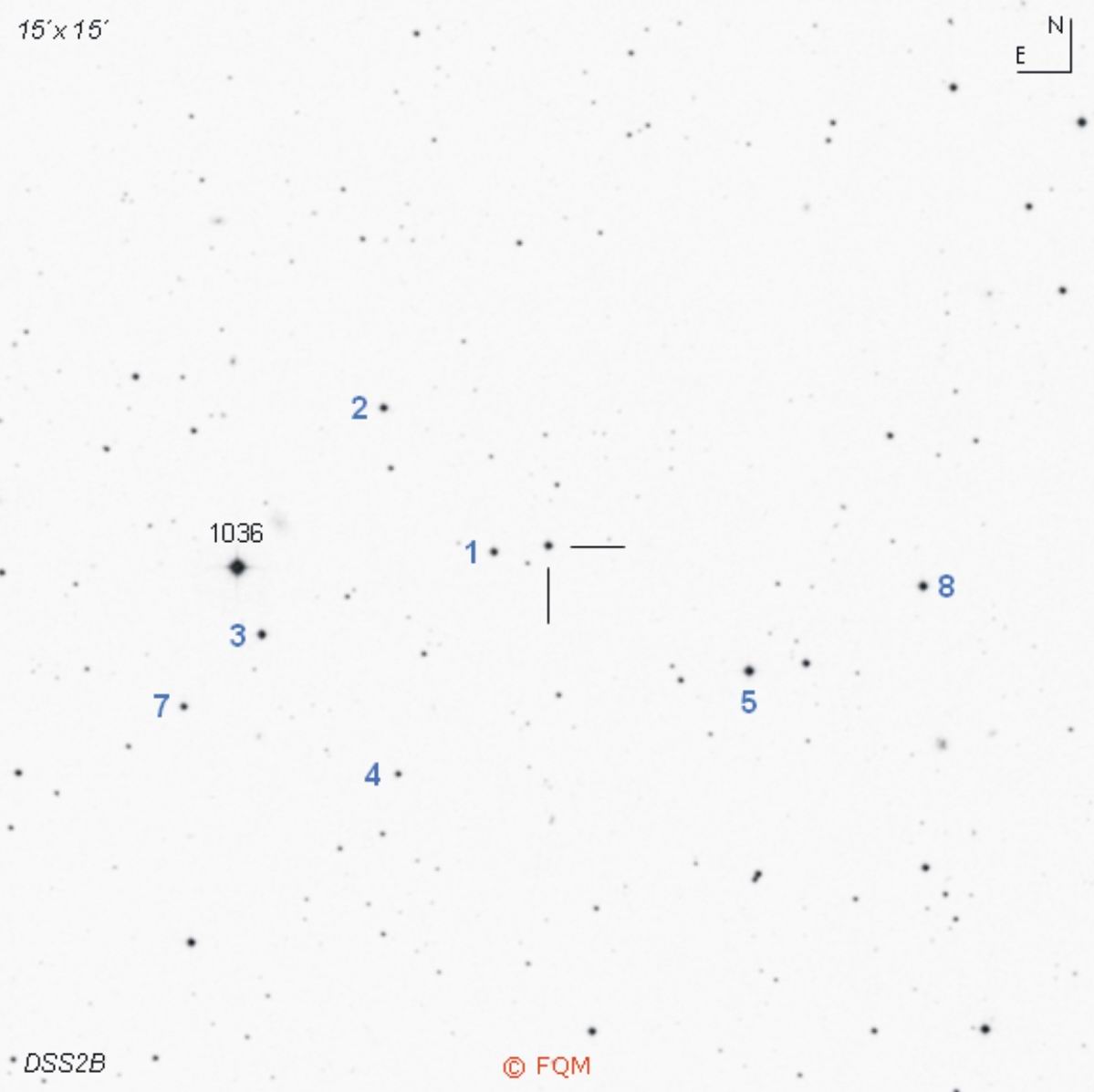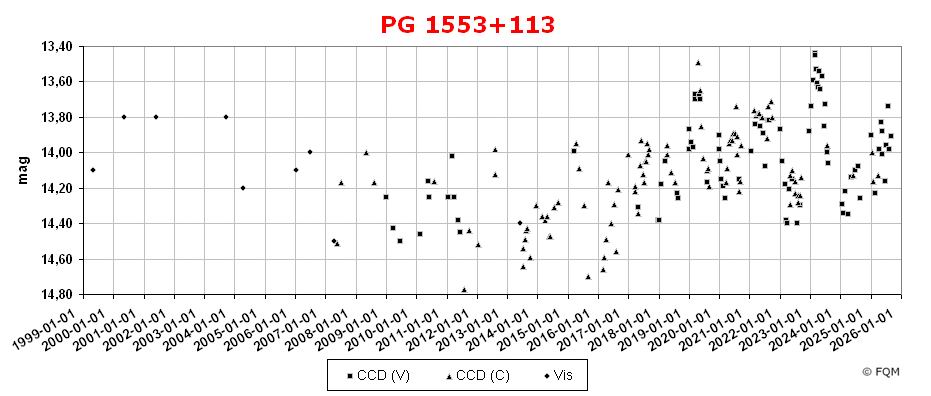
| Frankfurt Quasar Monitoring |
| PG 1553+113 |
| Cross-Identifications | TXS 1553+113, MG1 J155545+1110, 1553+113 SDSS J155542.97+111124.4, QSO B1553+113 87GB 155321.5+112002, 2E 1553.3+1120 0FGL J1555.8+1110, 2FGL J1555.7+1111 RX J1555.7+1111, 1ES 1553+113, PG 1553+11 2E 1553.3+1120, HESS J1555+111 |
| Equat. coordinates | RA 15 55 43.1 DE +11 11 24 (J2000) |
| Constellation | Serpens (Caput) |
| Type | BL Lac |
| Redshift | z=0.360 (2) (5) / z=0.49 (6) |
| Distance (2) (3) |
1365 Mpc / 1875 Mpc |
| Total mag range (mv) (7) (4) | 13.44 - 15.3 |
| Catalog Magnitude | 15. (1) (2) / 14.8 B (5) |
| Absolute Magnitude (1) | -26.8 MB (z=0.36) |
| Light Travel-Time (2) | 3.819 × 109 yrs / 5.03 × 109 yrs |

Comparison stars
| star | B | V | Rc | Ic (1) |
| 2 | 14.524 (0.023) |
13.828
(0.001) |
13.435 (0.001) | 13.078 (0.012) |
| 1 | 14.566 (0.024) | 13.920 (0.008) | 13.558 (0.004) | 13.242 (0.013) |
| 3 | 14.243 (0.024) | 13.406 (0.005) | 12.915 (0.003) | 12.454 (0.013) |
| 4 | 15.746 (0.028) | 14.508 (0.008) | 13.774 (0.006) | 13.166 (0.018) |
| 5 | 13.505 (0.024) | 12.832 (0.007) | 12.461 (0.005) | 12.130 (0.014) |
| 7 | 15.117 (0.026) | 14.167 (0.009) | 13.632 (0.005) | 13.184 (0.013) |
| 8 | 13.920 (0.024) | 13.108 (0.007) | 12.689 (0.009) | 12.330 (0.015) |


| PG
1553+113 is a bright BL Lac object in Serpens (Caput), about 5° E of
Delta Ser and close to the constellation Hercules. PG 1553+113 was
discovered as a blue stellar object by
the Palomar-Green
Bright Quasar Survey (PG)
between 1976
and 1982.
In the early 1980s, it was classified as a BL Lac object due to its
featureless spectrum. Besides a long list of quasars, PG
1553+113 was the only BL
Lacertae object that was discovered in
the course of the Palomar-Green
Bright Quasar Survey. Besides the optical and the radio, PG 1553+113
was also detected as an X-ray source and as a TeV gamma-ray
emitter. The true distance of this blazar is still not finally fixed. The redshift of 0.36 is considered erroneous, although still published by CDS and NED. Instead, latest results point to a redshift of z=0.49, corresponding to a light travel-time of 5×109 years. Very interesting news came from gamma-ray observations by Fermi-LAT, published in 2015. The gamma-ray flux showed nearly-periodic oscillation with a period of about 2.2 years, which were correlated with other multiwavelength observations. The most exciting possible explanation for this flux cycle is an oscillation of the jet produced by the gravitational pull of a second supermassive black hole. So probably, PG 1553+113 is one of the very few blazars known today which harbours a binary system of supermassive black holes at its galactic centre. In this context, see also blazar OJ 287. PG 1553+113 is slightly variable between about 13.5 mag and 15.3 mag in the optical. With a mean brightness of around mag 14 it is well suited for visual observers with telescopes of 8-inch and 10-inch of aperture. Due to its large distance of 5×109 light-years it remains a stellar object in any kind of telescope. CCD observers, as well as visual observers, shall use the comparison stars given above. ____________
An
interesting deep sky object is located only 4° to the east: IC 4593, a
bright planetary, also dubbed the "White-eyed Pea". The name refers to
the high surface brightness of this planetary and the whitish-green
colour of the small nebulous halo which surrounds the bright central
star.
Do not hesitate to use high powers! This planetary responds well to
both UHC- and O-III filters. Obervers who like to have look at another BL Lac object may turn to H 1722+119, a variable object about 22° E, at a distance of nearly 2×109 light-years. Another bright 15-mag quasar is MRK 877 at a distance of more than 1×109 light-years, 8.6° to the NE. |
| Abramowski, A., et al. 2015, ApJ 802, 65; The 2012 Flare of PG 1553+113 Seen with H.E.S.S. and Fermi-LAT. Ackermann, M., et al. 2015, ApJ 813L, 41; Multiwavelength Evidence for Quasi-periodic Modulation in the Gamma-Ray Blazar PG 1553+113. Aleksić, J., et al. 2012, ApJ, 748, 46; PG 1553+113: Five Years of Observations with MAGIC. Carangelo, N., Falomo, R., et al. 2003, A&A, 412, 651; Optical spectroscopy of BL Lac objects: new redshifts and mis-identified sources. Doroshenko, V.T., Sergeev, S.G., et al. 2005, Ap, 48, 304D; BVRI CCD-Photometry of Comparison Stars in the Neighborhoods of Galaxies with Active Nuclei. II Falomo, R., Treves, A., 1990, PASP, 102, 1120; PG 1553+11 - A bright optically selected BL Lacertae object. Green, R.F., Schmidt, M., Liebert, J., 1986, ApJS, 61, 305; The Palomar Green Catalogue of Ultraviolet-Excess Stellar Objects. Karge, S.; Helle Quasare für 8- bis 10-Zoll Teleskope. Ein Beobachtungsführer zur visuellen Beobachtung von Quasaren und BL Lacertae Objekten; Frankfurt 2005. Perlman, E.S., Stocke, J.T., et al. 1996, ApJS, 104, 251; The Einstein Slew Survey. Pica, A.J., Smith, A.G., et al. 1988, AJ, 96, 4; Long-term optical behavior of 144 compact extragalactic objects: 1969-1988. Snellen, I.A.G., et al. 2002, MNRAS, 329, 4; Automated optical identification of a large complete northern hemisphere sample of flat-spectrum radio sources with S6 cm > 200 mJy. Tavani, M., et al. 2018, ApJ 854, 11; The Blazar PG 1553+113 as a Binary System of Supermassive Black Holes. Véron-Cetty, M.-P., Véron, P. 2001, A&A 374, 92; A Catalogue of Quasars and Active Nuclei: 10th edition. Véron-Cetty, M.-P., Véron, P. 2003, A&A 412, 399; A Catalogue of Quasars and Active Nuclei: 11th edition. Véron-Cetty, M.-P., Véron, P. 2006, A&A 455, 776; A Catalogue of Quasars and Active Nuclei: 12th edition. Véron-Cetty, M.-P., Véron, P. 2010, A&A 518, 10; A Catalogue of Quasars and Active Nuclei: 13th edition. Wenzel, K., Düskau, W., 2003, SuW 2/03, 60; BL-Lacertae-Objekte - Eine Herausforderung für den Amateur. |
| Links: Landessternwarte Heidelberg Chara/PEGA Sloan Digital Sky Survey VSNET-Alert 27489: Exceptionally high optical state of Blazar PG 1553+113 (2023-03-06) |
| home |